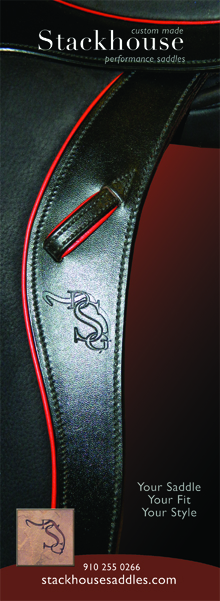Search the Site
Kristin's Blog post # 9: Looking the Part Versus Being the Part: Thoughts for the struggling working students of the world
To the countless working students I see struggling: do not get discouraged, and keep the focus on the quality of your riding.
The highly competitive upper echelons of the horse world are glamorous…to those who are not in it. I cannot think of another sport where the perception and the reality are so drastically different. I was first a working student at 15, and from that point to now I have seen probably twenty working students quit for every one that stuck around to really try and make it. And for every one that stuck around and put in her share of blood and tears, and worked a year or two with no days off, it is probably about a one in sixty chance they will ever get to a two star. I think there are a million reasons for this, but the one that has resonated with me the most lately is the trap that is the discrepancy between looking the part and being the part.
I was the poor kid (by horse standards!) in the rural south that spent the months leading up to Christmas highlighting my State Line Tack catalogue for every little thing I wanted. I remember how proud I was of my fancy plaid boot bag one year, or the newest half pad I got. I brought them to the barn and admired my horse as he stood in his glory. I would walk out in my new breeches and think I was this much closer to being Anne Kursinski. I skimmed through the magazines and was wowed by the custom vests the big names rode in, or the saddles that cost as much as all the horses I have ever owned put together (this is a fact). In short, I bought into the glamour of being a professional horse rider. I wanted to “make it:” the trailer with all the gadgets, the saddles for each horse, the perfectly coordinated outfits, the fancy halters with nameplates, the barn with a solarium and custom blanket bars and private paddocks, etc.
As someone now on the other side that lives in the heart of the event world, that has been in countless top barns around the country and spent days next to every big name at the shows, here is a secret: there is a difference between looking the part and being the part. And one of the main reasons that people don’t actually make it in this sport is that they cannot tell the difference between the two.
All those riders in the catalogues could give two shits what color their horses’ boots are, or if their saddle pad has piping that matches their polos, or whatever. Those are just the ideas that sell products in this industry by companies that sponsor those riders. Want to make it in this sport? Spend less time thinking about the new products you want, and less time admiring what someone else is wearing/driving/using, and a whole lot more time RIDING. And paying attention to other peoples’ riding. And reading about riding. And auditing clinics.
Don’t spend your time admiring brand name horses or products. Admire riding. Find people that you watch and are in awe of when they ride. And instead of buying a new saddle pad – buy a lesson with them.
It is really lovely to have the newest fancy imports. If I had a bajillion dollars, I might be riding “Fernhill I finally can afford you!” or “RF I won the lottery,” but I don’t. However, the only thing worse than not having a fancy import is having one and not being able to ride it. I can get XC stops left and right on a $2000 horse, I certainly don’t need an import for that! Focus on the quality of your riding and you will produce a quality horse to ride. You can't do this as a job if the very premise you start with is that it costs six figures to have something decent to mount. Recently an article in the Chronicle quoted someone as saying, “Most people don’t need a $35,000 horse. They need a $1,000 horse and $34,000 in lessons.” I second that! I have never spent more than $2400 on a horse, and I have never left the start box wishing I was on someone else's more expensive ride.
So many of the kids I see giving up on their dreams are misdirected in their thinking. It isn’t how fancy your trailer is, it is how well you ride what is sitting on it. It isn’t about how much your horse cost, it is about how well you can communicate with it. I hear a lot of kids quitting because they can’t afford the sport, but they spent their money in all the wrong ways. The things that are worth your money: lessons, lessons, lessons, a video camera to tape your lessons, a good vet who respects your money, lessons, lessons, xc safety gear, lessons.
Go around one of the big shows in this country and take a peek in top riders’ trailers. They are workmanlike, things are clean and organized, the trailers are kept well and safe, but for the most part there is nothing flashy going on. When you finally get a lesson with someone you do not get bonus points for a coordinated outfit with your horse, but you do get bonus points for sitting the trot well.
It can be hard to be surrounded by others that have everything new, all the time. Or have 16 horses to your 1. Or whatever. But welcome to the sport. The beauty of this sport is that you might find that person actually becomes one of your close friends, and you two are equal when the countdown is done and you head out the box. If your whip skills are better and you get your horse into the water, then you get to bring home blue…even if it is in an old rustbag of a trailer. Your horse doesn’t know the difference.
Mary King has been one of the top riders in the world for over a decade, and she has three acres and a (sorry Mary!)very basic little barn. She walks through her local town to get to the giant field where her horses live on 24/7 turnout, and brings them in to knock off and ride, then chucks them back out. She probably can’t even tell you what brand her bridle is, or what the footing in her ring is if she even has one, but she sure as hell can ride all of us under the table. Mary King is too busy being the part to worry about trying to look it.
So many of our top riders at the moment did not come from money. They came from decades of work, they came from being a student of the sport and not just a rider, they came from caring more about the quality of their seat than the quality of their saddle, and they came from being able to produce horses and not just buy them. Don’t ever forget that.






